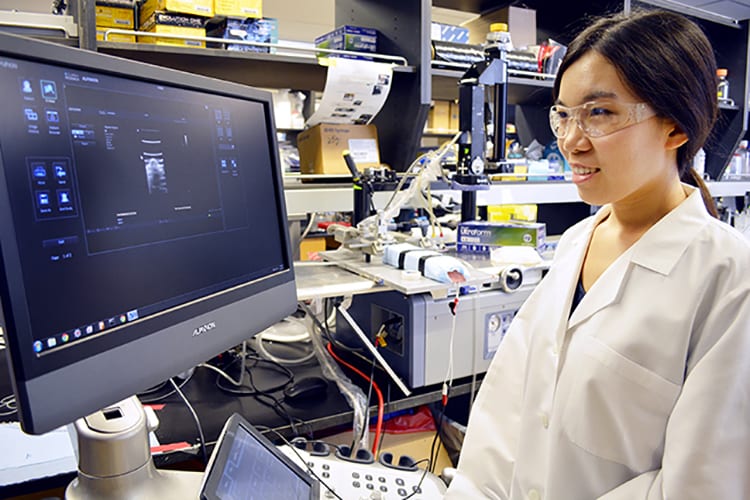
Tell me about your background.
I am from Yanan, a small town in north central China. I earned my Bachelor of Engineering in Energy, Power Systems and Automation from Xi’an Jiao Tong University in 2013. I have also studied as an exchange student in both National Tsinghua University and in University of Connecticut as an undergraduate. I stayed at the University of Connecticut and earned Master in Mechanical Engineering in 2015. After that, I joined Washington University to pursue my PhD in Mechanical Engineering & Material Science (MEMS) and started working in Dr. Hong Chen’s lab.
What led you to study at Washington University?
My favorite Chinese writer Jiangnan studied at Washington University 19 years ago and I have read a lot about WUSTL in his blogs, which talked so much about the attractive scenario and friendly people in this University. WUSTL has a great reputation in both academic research and clinical medicine as well, and all those made that as my dream school. Plus, my 10 year best friend is also studying here and I like the feel in staying in St. Louis.
What are your future career goals?
I want to stay in academia in the future. I would love to conduct research that can make real impact, benefit patients and do my best to find way to help people suffering from brain diseases. Plus, possibly, I would also love to teach or educate students and help students to develop their goals or plans.
What are you working on right now?
My current work is integrating focused ultrasound with drug delivery techniques to achieve noninvasive targeted brain drug delivery. The existence of blood-brain barrier (BBB) precludes 100% of large-molecule drugs and 98% of small-molecule from reaching the brain. Most of the available techniques for circumventing the BBB are either invasive (e.g. convection-enhanced delivery) or non-localized (e.g. intra-arterial injection of hyperosmotic solutions). We use focused ultrasound (FUS) to induce BBB disruption, allowing the intravenous injected agents get to the brain parenchyma at FUS treated site. As we recognized the intravenous injected drugs need to go through the blood circulation, which potentially associated with the toxic effect due to systemic exposure. In the meantime, I am also trying to develop FUS mediated intranasal delivery (FUSIN), which utilizes the nasal route for direct nose-to-brain drug administration, bypassing the BBB and minimizing systemic exposure. Then, FUS-induced microbubble cavitation can enhance the transport of IN administered agents to the FUS-targeted brain location.
What has been the most challenging aspect of this specific area of study?
As my background is in mechanical engineering, I am kind of lacking knowledge in the biology part. Plus, I am working on using one engineering technique to facilitate the brain drug delivery, which makes me always curious about the underlying mechanisms when something begins to work. Currently, the FUSIN works very well in delivering gold nano clusters and quantum dots (QDs) to the brainstem, however, we only have the hypothesis of how it happened and indirect evidence to support the hypothesis. I would love to find the direct evidence to support the mechanism, thus I would be more confident to predict how it works to deliver various agents.
What are your future plans for this subject?
It can be divided in two parts. First, I would love to study the mechanism using the two-photon microscopes and electron microscope. Second, we want to extend out FUS enhanced drug delivery technique to deliver a real drug for the treatment of a pediatric brainstem cancer.
Was there something in particular that led you to this subject of research?
Integrating ultrasound to brain drug delivery is a really cool technique which allows us to do both image and treatment at the same time. Especially when I learned that FUS combined with intranasal delivery can achieve around 2% delivery efficiency of gold nanoparticles ( 2% is a fairly high number in brain drug delivery), I was so excited and decided I must continue this work, and hope in the end this noninvasive, localized and high efficient drug deliver technique can be effective in patients.
Any other comments?
I really want to take this chance to thank my adviser Hong Chen for giving me so many opportunities and letting me work on these exciting projects. Also our technician, Yimei, who has helped with the post processes of my experiments. I am so lucky to be in our lab and all members are always like family members, being there to support and help me. I believe we will have wonderful journeys together in the coming days!
Summer Ye is a member of the Chen Lab.